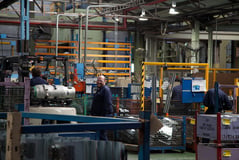How to Build a More Resilient Supply Chain
Brian Hoey - November 10, 2020

 According to a Gartner poll, only about a fifth of supply chain leaders report having a highly resilient supply chain. Of course, we can probably assume that 100% of supply chain leaders want a highly resilient supply chain—especially in the wake of the coronavirus crisis and its ongoing effects on global trade, shipping, and manufacturing—so what accounts for this gap? Is resiliency simply not a top priority when businesses are defining their future roadmaps for digital transformation and business development? Or is resiliency harder to come by than it may seem?
According to a Gartner poll, only about a fifth of supply chain leaders report having a highly resilient supply chain. Of course, we can probably assume that 100% of supply chain leaders want a highly resilient supply chain—especially in the wake of the coronavirus crisis and its ongoing effects on global trade, shipping, and manufacturing—so what accounts for this gap? Is resiliency simply not a top priority when businesses are defining their future roadmaps for digital transformation and business development? Or is resiliency harder to come by than it may seem?
More often than not, it’s probably the latter. But by understanding the areas of risk that are making your supply chain susceptible to stockouts, late shipments, and costly emergency measures, you can start to build out processes and networks that are more adaptable to changing situations and thus less susceptible to disruption. As the global supply chain becomes simultaneously more competitive and more connected, your ability to build in this added resiliency could quickly become mission critical.
Create Strong, Diverse Supplier Relationships
For starters, let’s talk about one of the practices that poses the biggest potential risk when it comes to your ability to respond productively to changes in the market or the value chain: single-sourcing. Single and sole sourcing processes (i.e. relying on just one source for your raw material needs) have been shown time and again to result in disruptions and delays. In the current moment, for instance, COVID-19’s impact on China’s industrial sector forced companies that were over-reliant on Chinese sources into tailspins; they couldn’t get the raw materials and parts that they needed to complete their production runs from their usual sources, and they didn’t have relationships with suppliers in different regions that they could fall back on—meaning that they were basically out of luck.
Though the current crisis is more or less unprecedented, this kind of pitfall certainly isn’t: any time there’s a natural disaster in a country that supplies important raw materials, manufacturers learn this same lesson all over again. For this reason, supply chain resiliency depends on creating relationships with diverse suppliers for your various parts and raw goods—such that you can avoid the kind of disruption we’ve been discussing. The same logic can be applied to production networks: if possible, you want to build in redundancies so that if one production plant goes down you aren’t forced to sit on your hands while you wait for a resolution. For some, the very idea of building these redundancies into sourcing and production seems inefficient—but that objection just highlights the importance of managing these “redundancies” in the smartest way possible. Rather than living with idle time because you have an abundance of production capacity, you can either build a network around flexible capacity (e.g. by partnering with a nearshore production plant on a flexible basis) or strive for a kind of “lean diversity” (e.g. by planning proactively enough to gain value of all “redundant” suppliers without risking production hiccups).
Balance Buffer Stock Costs with Changing Risk Levels
In the section above, we point to the critical balancing act that most supply chains have to perform: creating stability without inflating your costs. When it comes to your supplier network, you need to balance the flexibility you get from having multiple sourcing options with the costs of maintaining relationships with multiple sources. In inventory planning, you have to grapple with an equally thorny problem—balancing the costs of maintaining buffer stock with the risks of going lean. Ostensibly, a larger buffer or safety should make your supply chain more resilient, since you won’t get stuck with stockouts if there’s an unexpected demand spike. On the flipside, however, the reduced capital commitments that come with a comparatively lean inventory strategy can impart some flexibility into your supply chain, if for instance it allows you to free up cash flow to use for unplanned special trips on an ad hoc basis.
Obviously, every business is going to have to find the balance that best fits their risk tolerance and corporate strategy—but generally speaking, the best way to get closer to this optimal balance is to radically improve your forecasts. Simply put, the more closely you can estimate future demand levels (both for your own goods and for the parts you source and logistics capacity you need to reserve), the more easily you reduce buffer stock without increasing risk. If you combine this with the kinds of multi-sourcing practices we discussed above, you can effectively reduce the frequency with which you’re caught off guard by the unexpected.
Enhance Your End-to-End Visibility
You might be getting the idea as you read this that supply chain resiliency comes less from particular elements than from different elements interworked flexibly. If you have processes and networks with a degree of built-in flexibility, the only remaining challenge is to operationalize that flexibility into improved planning, scheduling, and disruption responses. And how do you do that? Step one is to prioritize visibility. You can make this a reality through a number of tactics, but most will involve adopting the right IT infrastructure and creating data streams that can give live updates across different touchpoints on the supply chain. This might mean shared or interoperable planning modules between you and your suppliers—and it might mean flexible, postmodern ERP deployments that promote interworking between different solutions in the same environment.
However you boost your visibility, the goal is to be able to visualize the whole supply chain for a given planning horizon and analyze future plans and conditions from there. Not only does this put you in a position to gain a better sense of any latent risks in your value chain, it also gives you the basis of data you need to adopt advanced analytics and AI-based workflows that can help you improve your forecasting and scheduling even further. In an environment like this, a planner could start with an optimized production plan for forecasted demand, identify a potential disruption, and then automatically select the best replanning scenario from the options your solution presents to you. In this way, you gain resilience to disruption through speed and flexibility.
LATEST POSTS
- Understand Why Production Planning Needs Specialized Solutions
- Understand Circular Economy in The Manufacturing Industry
- How Can Industry 4.0 IT Integration Be Achieved Smoothly?
- The Significance of Order Sequencing in Discrete Manufacturing
- How to improve your Supply Chain Management: The Power of Control Towers



